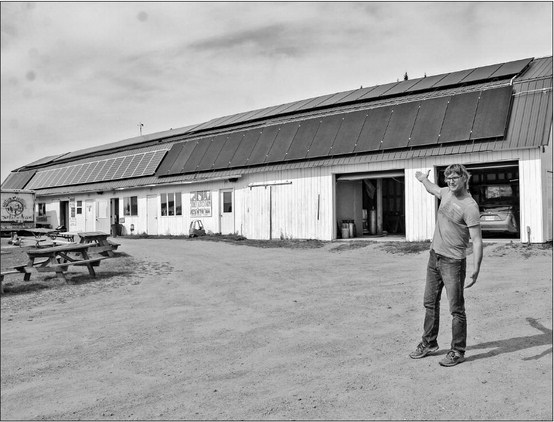Solar: the energy of the future


By Nathaniel Underwood
Tony Schultz has always tried to put a focus on sustainability and making sure to have a diverse set of offerings on his family farm just north of Athens.
The land on which the Stoney Acres farm sits has been in his family since the 1940s, and as the third generation to work the land, Schultz has taken several new approaches in how to make a small family farm work in a world in which larger farms are grabbing bigger pieces of the pie.
A focus on diverse sets of organic vegetables, as well as offerings of beef, pork, eggs and mushrooms that he is able to get to customers at various points of sale and additions of “Pizza on the Farm” nights and a brewery showcase the variety in products that Stoney Acres has to offer.
Schultz does not just apply the mentality of sustainability and diversification to his products, however, as the new additions to his solar array stand as an obvious testament to. The black solar cell panels that now adorn the southern roof of one of the farm’s buildings are immediately recognizable to any visitors to Stoney Acres. The addition of solar energy to complement more traditional energy sources certainly fits in with Schultz’s focus on renewability, which he cites as one of his motivators towards looking into the projects in the first place.
“The theme is about sustainability,” he said. “Can we continue to do this for a thousand years, indefinitely into the future? Where are we getting our energy from? Is it
See SOLAR page 17
SOLAR ON DISPLAY - Tony Schultz stands with the new solar panel system he had installed one of his farm buildings’ roof in 2023. The energy collection system has cut Schultz’s peak season electricity bills in half. STAFF PHOTO/NATHANIEL UNDERWOOD Solar
Continued from page 16
finite or is it a sustainable thing?”
However, it also needed to make financial sense, something that Schultz noted as the other piece to the puzzle when he started out with a small section of panels in 2013.
“In 2012, our energy bill was like 300 dollars,” he said. “We put up those panels, they were like 8.3 kilowatts rated at the time and our energy bill went down to 50 bucks a month.”
While Schultz initially started out with a small section of panels back in 2013 and was impressed by the results at the time, expansion of his business in recent years pushed him to invest further into solar power.
“Over the course of their life, they decrease in their efficiency, and they are just less efficient panels [than panels today]. I have also increased the capacity of my farm and the energy needs of my farm,” he explained. “In shifting to Pizza on the Farm especially and adding the brewery. So I’ve added a second cooler, which is basically running an air conditioner all the time. I’ve added a walk-in freezer. I have 13 chest freezers compared to three in 2013. But I need all these because I’m filling them up with ingredients. With having the brewery, we have fermenters, one is jacketed and two are not. There are advantages and disadvantages to brewing beer, but an unjacketed fermenter is like an exposed refrigerator at times. It takes a lot of energy because you have to cool it but it’s also subject to the air temperature. So I’ve added all this capacity.”
With the expansion, Schultz noted that his energy bills had nearly doubled the 2012 totals, reaching nearly $800 per month last summer. When debating how to best improve the efficiency of his business, Schultz decided that trying to find a way to decrease his fixed costs, like the energy bill, would be the best route for him.
“My priority, because I feel like I’m already so stretched a little bit on my farm, is that I want to lower my fixed costs,” he said. “So it’s an economic decision as well as a sustainability one. What are the things I have to pay for all the time that I can lessen the cost of? One is the energy bill every month.”
Schultz recently upgraded and expanded his array in 2023, going from a 8.3 kilowatt panel system to an 18.3 kilowatt system that now covers most of the roofing.
The results were, from an economic standpoint, almost immediate.
Last September, during Schultz’s peak energy usage season, his bill went from almost $800 in August to under $400 after the new solar panels were integrated. In February, when many of his high consumption items like coolers were shut down, he noted that his farm was able to entirely run off of the energy collected by the panels and that he only had to pay a base fee for his electricity that month.
“I thought, ‘okay, I’m going to cut my energy bill in half. It’s about $800, I’ll put this up, and should be about $400.’ But it’s outperformed that,” Schultz noted. “Having these has just made me more energy conscious.”
In addition to significant savings that the panels themselves have provided, Schultz also said that the installation made him consider where else he could save money on his electrical bill. Upgrades to his water heater system and a move to unload his display freezer every evening after pizza night saved him an additional $200 per month.
Part of what made his 2023 expansion of the solar array possible was the USDA’s Rural Energy for America Program (REAP) grant. Schultz stated that the grant helped finance his first solar project 10 years prior and that having it again in 2023 made the initial investment required to have the array installed much more feasible. With the results he has seen on his own farm, he recommends that others should look into similar projects.
“If you are an agricultural business, you are probably eligible for the REAP grant,” Schultz said. “I don’t know what limits there are on your size of your operation, but I know it’s going to cover approximately 40 percent of your project costs. I had to put the money up front, but then they just sent me a check when it was installed and verified. To me, if you’re a business, it’s just a way to lower your fixed costs. We just need diverse forms of energy at this point in history.”
“I’ve made this decision partially out of the ethics of my farm, but it’s also a very strict economic decision,” he added. “People are always curious about them and I tell them that I could either buy a tractor or I could buy this, and this is earning me nine percent. And a new tractor could earn me nine percent but I have to really work to get that out of the tractor. With [the panels], that’s just sitting there, earning me nine percent. I’m a small business, but that’s still a chunk that I’m now able to reinvest into other portions of my farm.”
WELCOME TO THE FARM - One of Schultz’s many offerings is a “pizza on the farm” night, where guests can order pizzas cooked in stone ovens made largely of ingredients from the farm.
STAFF PHOTO/NATHANIEL UNDERWOOD

